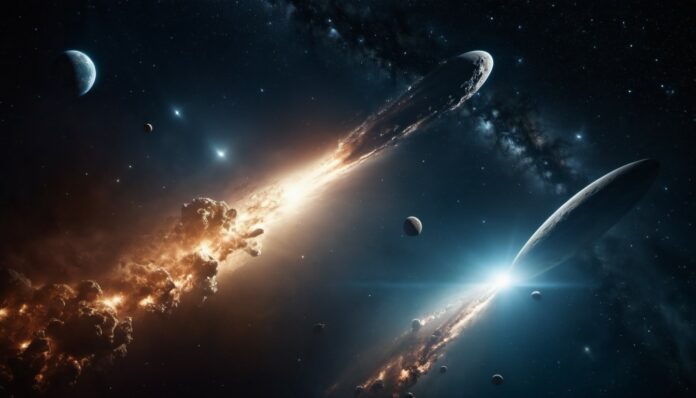Interesting Facts About Comets – it’s an opportunity to learn more about celestial bodies orbiting the Sun. Comets are encountered in the cultures of many nations.
Often they are associated by people with something negative and destructive. However, modern research has been able to prove that they actually represent “tailed” comets.
- The solid core of a comet, known as the nucleus, is typically composed of water ice, frozen gases, dust, and rocky material. It’s usually only a few kilometers in diameter.
- As a comet approaches the Sun, its ice starts to vaporize, creating a glowing envelope called a coma. This happens due to the Sun’s heat, which releases gas and dust from the nucleus.
- Comets often develop two tails: a gas tail (ion tail) and a dust tail. The ion tail, made of ionized gases, always points directly away from the Sun due to the solar wind. The dust tail, composed of small solid particles, trails behind the comet along its orbit.
- One of the most famous comets is Halley’s Comet, which is visible from Earth approximately every 76 years. It was last seen in 1986 and will return in 2061.
- Short-period comets (those with orbits lasting less than 200 years) are believed to originate from the Kuiper Belt, a region beyond Neptune. Long-period comets (with orbits longer than 200 years) are thought to come from the distant Oort Cloud.
- It’s interesting that as of 2018, astronomers have discovered 6339 comets.
- The so-called “tail” of a comet consists of gas and cosmic dust.
- In the early last century, a bright comet named Halley could be seen in the sky without the aid of telescopes. Some entrepreneurs started selling people gas masks and umbrellas supposedly protecting them from comets.
- Did you know that the word “comet” is translated from ancient Greek as “hairy”? This is because in the imagination of the Greeks, comets were stars with long hair.
- The core of this celestial body constitutes about 90% of its mass.
- It’s interesting that the mentioned spacecraft approached the comet for more than 10 years.
- The largest comet nucleus ever recorded had a diameter of approximately 40 km.
- Comets can have fantastically long tails. For example, the tail of Comet Hyakutake was about 580 million km long!
- It turns out that scientists still cannot explain where comets come from. According to one version, they could have originated from the remnants of matter during the formation of the Solar System.
- It’s interesting that comets have their own atmosphere.
- Comets have been observed for thousands of years and have often been regarded as omens or portents in various cultures. Ancient Chinese astronomers kept detailed records of comet appearances.
- Several missions have been launched to study comets up close. For instance, the European Space Agency’s Rosetta mission successfully landed the Philae probe on Comet 67P/Churyumov-Gerasimenko in 2014, providing valuable data about its composition and structure.
- A comet’s brightness can change dramatically as it moves closer to or farther from the Sun. Some comets become visible to the naked eye, while others can only be seen through telescopes.
- Some scientists theorize that comets may have played a role in delivering water and organic molecules to Earth, potentially contributing to the emergence of life.
- Jupiter’s powerful gravity attracts many comets and other celestial bodies towards it, which theoretically could collide with Earth (see interesting facts about Jupiter). Who knows, maybe Jupiter was indeed created for this purpose.
